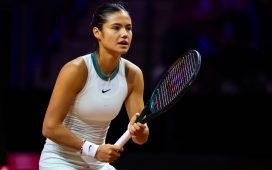As Hong Kong marched for an 11th consecutive week in August, 20 miles away a drone floated noiselessly over the Shenzhen Bay Sports Centre. It captured coordinated teams of men running across the lush grass-painted lines of a football pitch, but there were no footballs in sight. Instead, dozens of paramilitary vehicles from China’s People’s Armed Police paraded the streets of Shenzhen and settled in the arena. Satellite pictures showed more than 100 sitting tidily around the perimeter of the pitch. The military exercises were widely perceived to be an intimidation tactic, to show what China could do in Hong Kong if it really wanted to. Sports and politics were in perfect harmony.
There will be none of those vehicles on show at the Shenzhen Bay Sports Centre. Instead, the eight best women’s tennis players and doubles teams in the world have descended on the complex as the WTA Finals comes to Shenzhen for the first time.
Pound for pound, it is essentially the most lucrative tennis event in history – men’s or women’s. The figures are astonishing: the total prize money stands at $14m (£10.75m), far outstripping the $8m on offer by the ATP’s equivalent event at the O2 Arena in London. If undefeated, the champion will take home $4.725m compared with the record $3.8m pocketed by the US Open champions this year.
Steve Simon, the WTA’s CEO, has said: “There was a true commitment here, trying to do something about ‘walking the walk’ when it comes to women’s empowerment. It made a huge impression on us when we saw someone who didn’t just talk the talk.”
It is clearly a symbolic moment: women being paid more than men, slowly gaining even more access to the money usually reserved for male athletes.
Money is always symbolic in women’s tennis because of everything it comes from. Forty‑nine years ago, the Women’s Tennis Association was forged partly in the defiant flames of a different era of protests. In We Have Come A Long Way, her 1989 history of women’s tennis, Billie Jean King wrote: “The issues of the previous decade [the 60s] – the Vietnam war, racial prejudice, the environment and women’s rights – were more a part of our consciousness than ever.”
In a sport governed from top to bottom by men, female players had long grown accustomed to competing for fractions of the prize money gifted to their male colleagues.

Just before the 1970 US Open, the tennis promoter Jack Kramer offered the men prize money of $12,500 and the women $1,500 for the Pacific Southwest Championships in California. Women who failed to reach the quarter-finals would earn nothing but he implored them to play for the love of the game.
It was an insult too far. As Kramer threatened to banish them from his US Lawn Tennis Association and their status in other major events came under fire, a group of players led by King risked everything by choosing to boycott his event in favour of forming their own tour.
In 1973, the Virginia Slims Circuit made way for the WTA Tour and soon became the machine that now makes millionaires on a monthly basis. On the day the “Original Nine” announced that they would boycott Kramer’s event, they signed a contract worth $1 and each held up a dollar bill to the sky.
It can be easy to forget just how big women’s tennis is. In an intolerant world where even its greatest player, Serena Williams, still receives scorn for the audacity of being an athlete with muscles, women’s tennis is a triumph. For the past 49 years, it has been the largest women’s sport – nothing else comes close. On the Forbes list of highest-paid female athletes this year, the top 11 names are tennis players. On and off the court, the WTA has proven capable of generating transcendent superstars and delivering profound cultural moments.
None of those moments have been more pivotal to recent WTA history than the rise of Li Na, the charismatic Chinese player who broke away from the centralised tennis system and became a champion. Her triumphs at the French Open in 2011 and the Australian Open in 2014 made small ripples in the west but in China she reshaped the sporting scene in her image.
The WTA has since spent more than half a decade pushing hard into China. It now has offices in Beijing and holds nine tournaments in the country, while eight remain in the United States. One day at a Chinese tournament makes it clear why. Their Chinese partners do not think small; with each new event comes a towering new stadium and vast sums from major sponsors to tennis projects stretching far beyond the tournament.

While the WTA was in the midst of a mammoth eight weeks in China, the way people speak about the country’s rising presence in world sporting events shifted. When the Houston Rockets general manager, Daryl Morey, tweeted his support for the Hong Kong pro-democracy protests, China’s incensed reaction pushed the league into an international incident. China promised retribution and has acted, most recently refusing to show the opening game of the NBA season.
The NBA’s attempts to simultaneously appease China and the US has garnered criticism across the board. The widespread attempts for sporting leagues to capitalise on the capital China possesses has come under greater scrutiny, and there are few sporting bodies navigating China as zealously as the WTA.
The saga should be a point of reflection for the WTA, in part because, unlike most other sporting leagues, it is an organisation born out of fighting oppression and the status quo, and its foundations are about much more than just tennis.
It is now clear what would happen if any player or affiliated person were to make the most basic stand, but it is not clear how the WTA would react. Taking the big money from a country with an authoritarian government will always come at a cost and presenting its business decision in terms of empowerment is unreasonable as long as Hong Kong burns next door and Uighur Muslims are being sent to re-education camps on the other side of the country.
One reason Chinese municipal governments are so willing to collaborate with the WTA is because it is an opportunity to project the best of their cities on to the big stage. Between random beautiful camera shots of the city’s skyline, Shenzhen will showcase an exciting period for the WTA as young players such as Naomi Osaka, Bianca Andreescu and Ashleigh Barty continue to form new rivalries and contest thrilling matches. They may just be thrilling enough for viewers to forget momentarily what is happening 20 miles away and the tanks that lined up in the city weeks earlier. For the city government, that is probably the point.
The WTA has unwittingly landed in the middle of the biggest sports politics story of the year, but that was its choice. More stories like this one will unfold over the next weeks, months and years. Questions will be asked of where the WTA stands and how much its money means to it. The organisation will be judged accordingly.








